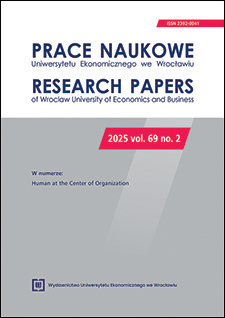Impact of Organizational Culture on Perceptionsof Career Success among Women
DOI:
https://doi.org/10.15611/pn.2025.2.06Keywords:
Women's professional success, organizational culture, gender equality, managing the culture of the organizationAbstract
Aim: The objective of this study is to determine the impact of organizational culture on women’s career success and their perception of success, taking into account the interrelationships between variables.
Methodology: The research encompasses a literature review and quantitative analysis using the CAVI method. The sample set consisted of 45 respondents. The article is based on empirical research conducted in 2024. Relationships between variables were analyzed using Spearman correlation and regression.
Results: The results partially confirmed the hypothesis that organizational culture influences women’s perception of career success. Specifically, organizational culture exhibiting feminine characteristics and the elimination of gender stereotypes promote women’s sense of career success.
Implications and recommendations: Inclusiveness, work-life balance, mentoring, and flexible forms of employment were key factors identified as supporting women’s career development. Furthermore, a key contributor in this transformation is the transition from traditional masculine organizational structures towards more feminine models. Given the rapid pace of social and economic changes, consistent and systematic examination of organizational culture appears to be justified.
Originality/value: The results presented in this research highlight the factors that may contribute to promoting women’s career development.Downloads
References
Bańka, A. (2009). Nowe kierunki rozwoju współczesnego poradnictwa zawodowego. Retrieved from www.doradca-zawodowy.pl
Bartkowiak, G. (2000). Wybrane determinanty sukcesu zawodowego w opinii menedżerów. In S. Witkowski (Ed.). Psycho-logiczne wyznaczniki sukcesu w zarządzaniu (pp. 15-32). Wydawnictwo Uniwersytetu Wrocławskiego.
Bedyńska, S. (2013). Długofalowe skutki zagrożenia stereotypem: Moderacyjna rola identyfikacji z własną grupą i z dziedziną. Studia Psychologiczne, 51(3).
Briscoe, J. P., & Hall, D. T. (2006). The Interplay of Boundaryless and Protean Careers: Combinations and Implications. Journal of Vocational Behavior, 69(1), 4-18.
Cewińska, J., Mizera-Pęczek, P. (2017). Oblicza różnorodności w miejscu pracy. Wydawnictwo SIZ.
Crisp, R. J., Bache, L. M., & Maitner, A. T. (2009). Dynamics of Social Comparison in Counter-Stereotypic Domains: Stereotype Boost, not Stereotype Threat, for Women Engineering Majors. Social Influence, 4(3), 171-184.
Cronbach, L.J. (1951). Coefficient Alpha and the Internal Structure of Tests. Psychometrika, 16, 297-334. https://doi.org/10.1007/BF02310555
Cullen, M. J., Waters, S. D., & Sackett, P. R. (2006). Testing Stereotype Threat Theory Predictions for Math-Identified and Non--Math-Identified Students by Gender. Human Performance, 19(4), 421-440.
Derr, C. B. (1987). What Value Is Your Management Style? Personnel Journal, 66(6), 74.
Derr, C. B., Jones, C. Toomey, E. L. (1988). Managing High‐Potential Employees: Current Practices in Thirty‐Three US Corporations. Human Resource Management, 27(3), 273-290.
Dornan, J., & Maxwell, J. C. (1995). Strategia sukcesu. Studio Emka.
Driver, M. J. (1982). Career Issues in Human Resource Management. Prentice-Hall.
Elias N. (1969). Über den Prozess der Zivilisation. In Schlüsselwerke der Emotionssoziologie. Springer Fachmedien Wiesbaden.
Fisher, R. A. (1922). The Goodness of Fit of Regression Formulae, and the Distribution of Regression Coefficients. Journal of the Royal Statistical Society, 85(4), 597-612. https://doi.org/10.2307/2341124
Ghauri, P. N., & Cateora, P. R. (2010). International Marketing. McGraw Hill Education.
Gray, R., Owen, D., & Sopher, M. J. (1998). Setting up a Control System for Your Organization. Nonprofit World, 16(3), 65-76.
Griffin R. W. (1996). Podstawy zarządzania organizacjami. PWN.
Hofstede G. (1984). Culture’s Consequences. International Differences in Work – Related Values. Sage.
Hofstede, G., & Hofstede, G. J. (2007). Kultury i organizacje. PWE.
Hays Poland. (2023). Kobiety na rynku pracy 2023. Polityka DE&I w praktyce. Raport Hays Poland. https://www.hays.pl/kobiety/2023
Hornowska, E., Paluchowski, W. J. (2001). Rozwój zawodowy – podstawowe założenia. In T. Listwan & S. Witkowski (Eds.), Sukces w zarządzaniu. Problemy organizacyjno-zarządcze i psychospołeczne (pp. 230-256).
Kasprzak, E. (2013). Poczucie jakości życia pracowników realizujących różne wzory kariery zawodowej. Wydawnictwo Uniwersytetu Kazimierza Wielkiego.
Kets de Vries, M. F. R. (2006). Niebezpieczeństwa niskiej samooceny: czy czujesz się jak oszust? Harvard Business Review Polska, 44.
Kinicki, A. J., Jacobson, K. J., Galvin, B. M., & Prussia, G. E. (2011). A Multilevel Systems Model of Leadership. Journal of Leadership & Organizational Studies, 18(2), 133-149.
Kirk, J. J., & Kirk, L. D. (1995). Training Games for Career Development. McGraw-Hill.
Kołodko, G. (2010). Neoliberalizm i światowy kryzys gospodarczy. Ekonomista, 1, 23-30.
Kożusznik B., Adamiec M. (1993). Zarządzanie Zasobami Ludzkimi. Aktor – Kreator – Inspirator. Wydawnictwo AKADE.
Krupski, R. (1997). Strategia sukcesu. In T. Listwan (Ed.), Sukces w zarządzaniu. Wydawnictwo Akademii Ekonomicznej we Wrocławiu.
Kupczyk, T. (2002). Czynniki sukcesu polskich menedżerów [PhD thesis]. Akademia Ekonomiczna we Wrocławiu, Wydział Zarzadzania i Informatyki.
Łucewicz, J. (1996). Kultura organizacyjna jako wyznacznik postaw menedżerów wobec sukcesu. Prace Psychologiczne, XLVI.
Obuchowski, K. (1985). Adaptacja twórcza. Książka i Wiedza, 128.
OECD. (2010). Sprawozdanie dotyczące przygotowania Strategii Zielonego Wzrostu. https://www.oecd-ilibrary.org
Ou, A. Y., Tsui, A. S., Kinicki, A. J., Waldman, D. A., Xiao, Z., & Song, L. J. (2014). Humble Chief Executive Officers’ Connections to Top Management Team Integration and Middle Managers’ Responses. Administrative Science Quarterly, 59(1), 34-72.
Penc, J. (1997). Leksykon biznesu. Placet.
Płowiec, K. (2001). Kobiety na rynku pracy. Konferencja w Łodzi. Polityka Społeczna, 7, 32-35.
Pocztowski A. (2008). Zarządzanie zasobami ludzkimi. Strategie – procesy – metody. Polskie Wydawnictwo Ekonomiczne.
Polski Instytut Ekonomiczny (2023). Sytuacja kobiet na rynku pracy z perspektywy społeczno-ekonomicznego. https://pie.net.pl/wp-content/uploads/2023/05/PIE-Raport_Sytuacja_kobiet.pdf
Pszczołowski, T. (1978). Organizacja od dołu i od góry. Wiedza Powszechna.
Rakowska, A. (2007). Kompetencje menedżerskie kadry kierowniczej we współczesnych organizacjach. Wydawnictwo Uniwersytetu Marii Curie Skłodowskiej.
R Core Team. (2023). R: A Language and Environment for Statistical Computing. Retrieved from: https://www.R-project.org/
Schein, E. H. (1978). Career Dynamics: Matching Individual and Organizational Needs (Vol. 6834). Addison-Wesley Publishing Company.
Schein, E. H. (1985). Organisational Culture and Leadership. Jossey-Bass.
Schein, E. H. (1990). Career Anchors: Discovering Your Real Values. Jossey-Bass/Pfeiffer.
Schein, E. H. (1995). Career Survival: Strategic Job and Role Planning. Pfeiffer & Company.
Snyder, C., Sympon, S. C., Ybasco, F.C., Boders, F., Babyak, M. A., & Higgins, R. L. (1996). Development and Validation of the State Hope Scale. Journal of Personality and Social Psychology, 70(2), 321.
Spearman, C. (1904). The Proof and Measurement of Association between Two Things. The American Journal of Psychology, 15(1), 72-101. https://doi.org/10.2307/1412159
Sturman, M. C., Shao, L., Katz, J. H. (2012). The Effect of Culture on the Curvilinear Relationship between Performance and Turnover. Journal of Applied Psychology, 97(1), 46.
Super, D. E. (1976). Career Education and the Meanings of Work. Wydawnictwo Washington D.C.
Šmid, W. (2000). Leksykon menedżera, słownik angielsko-polski. Wydawnictwo Profesjonalnej Szkoły Biznesu.
Szałkowski, A. (Ed.) (2002). Rozwój personelu. Wydawnictwo AE w Krakowie.
The World Bank. (2012). Inclusive Green Growth: The Pathway to Sustainable Development.
Wickham, H. (2016). ggplot2: Elegant Graphics for Data Analysis. Springer-Verlag.
Wilensky, H. L. (1961). Orderly Careers and Social Participation: The Impact of Work History on Social Integration in the Middle Mass. American Sociological Review, 26(4), 521-539.
Zbiegień-Maciąg, L. (2005). Kultura w organizacji. Identyfikacja kultur znanych firm. PWN.
Downloads
Published
License
Copyright (c) 2025 Małgorzata Kluska-Nowicka

This work is licensed under a Creative Commons Attribution-ShareAlike 4.0 International License.
Accepted 2025-01-15
Published 2025-07-22









